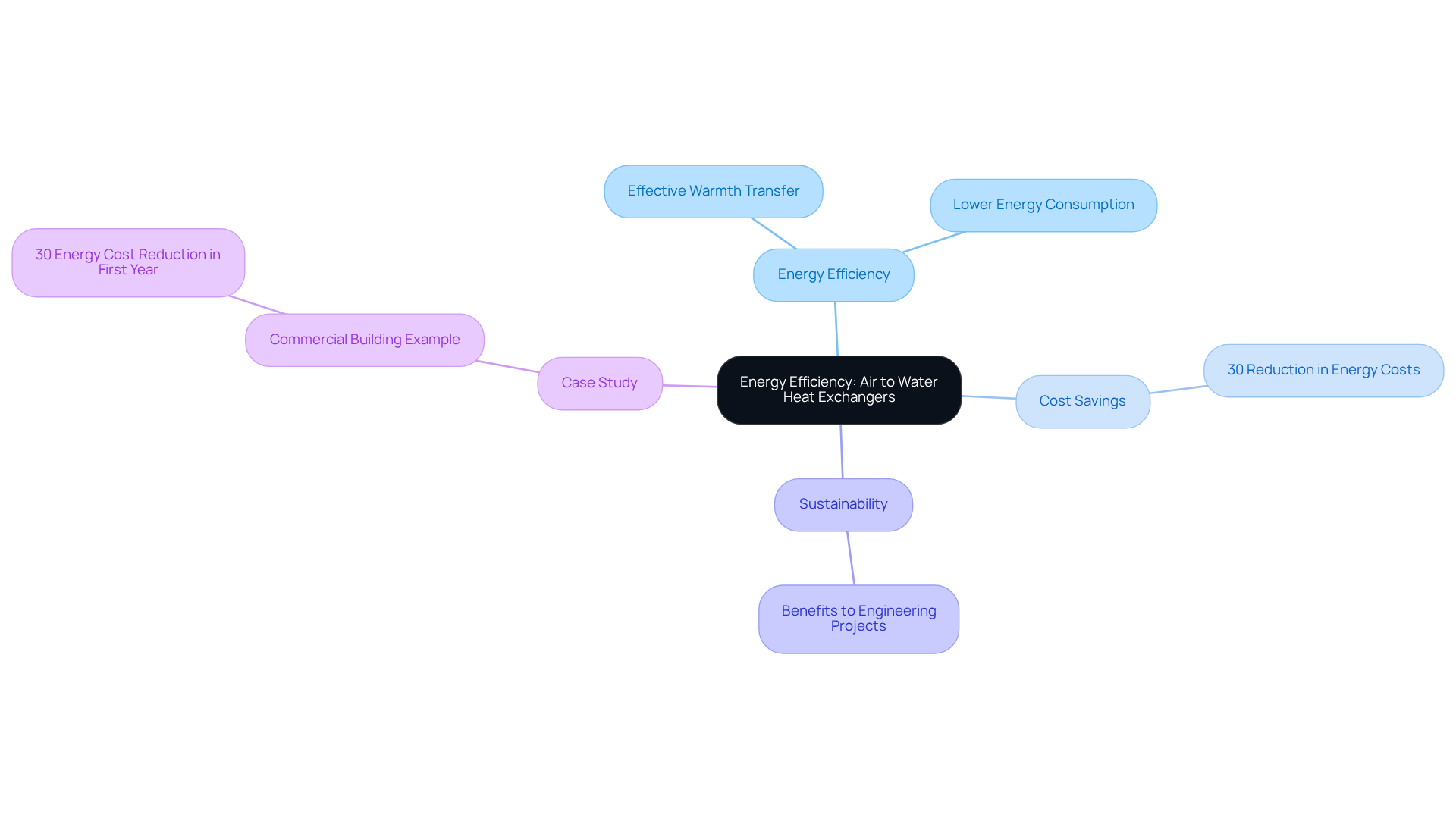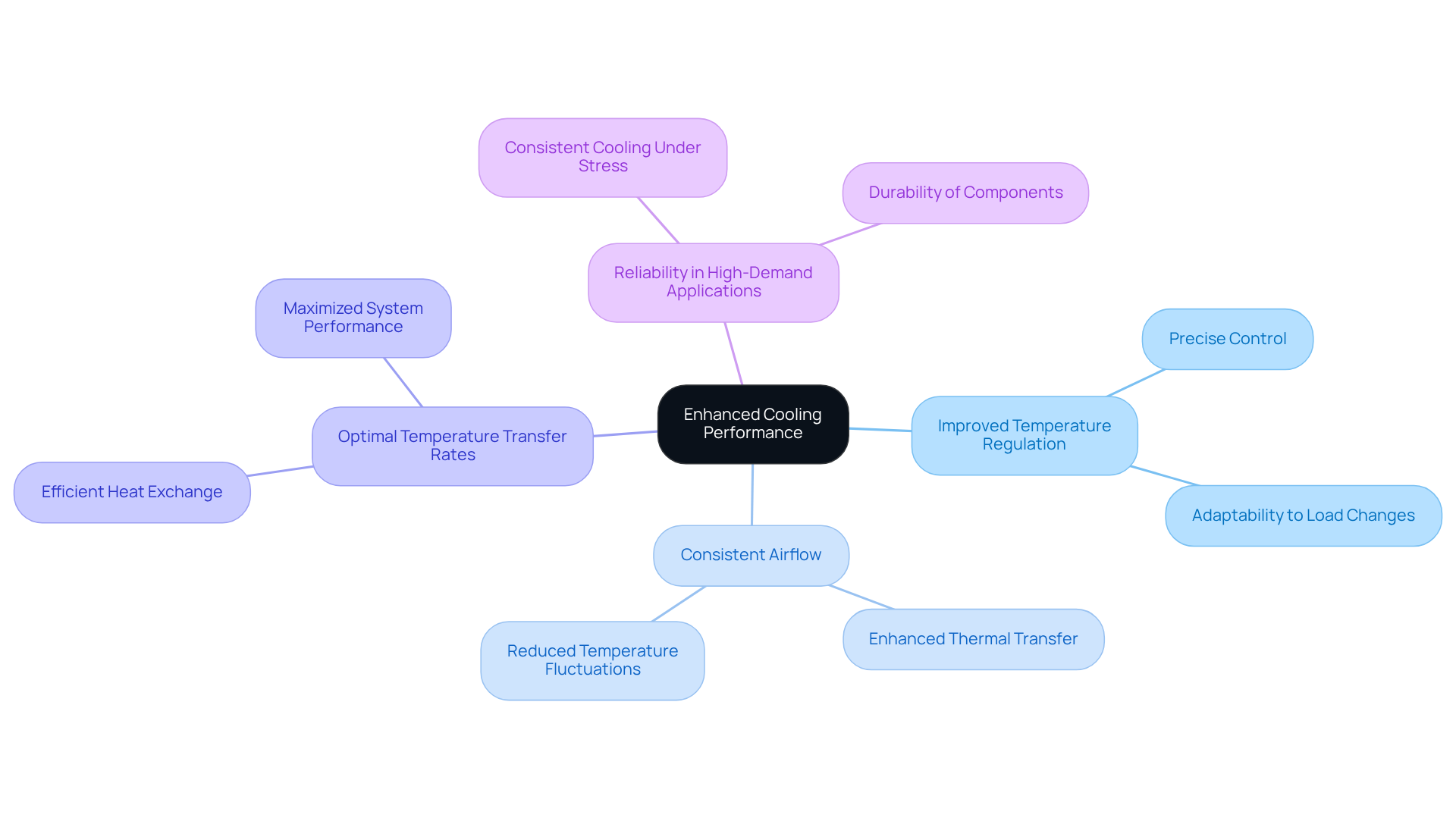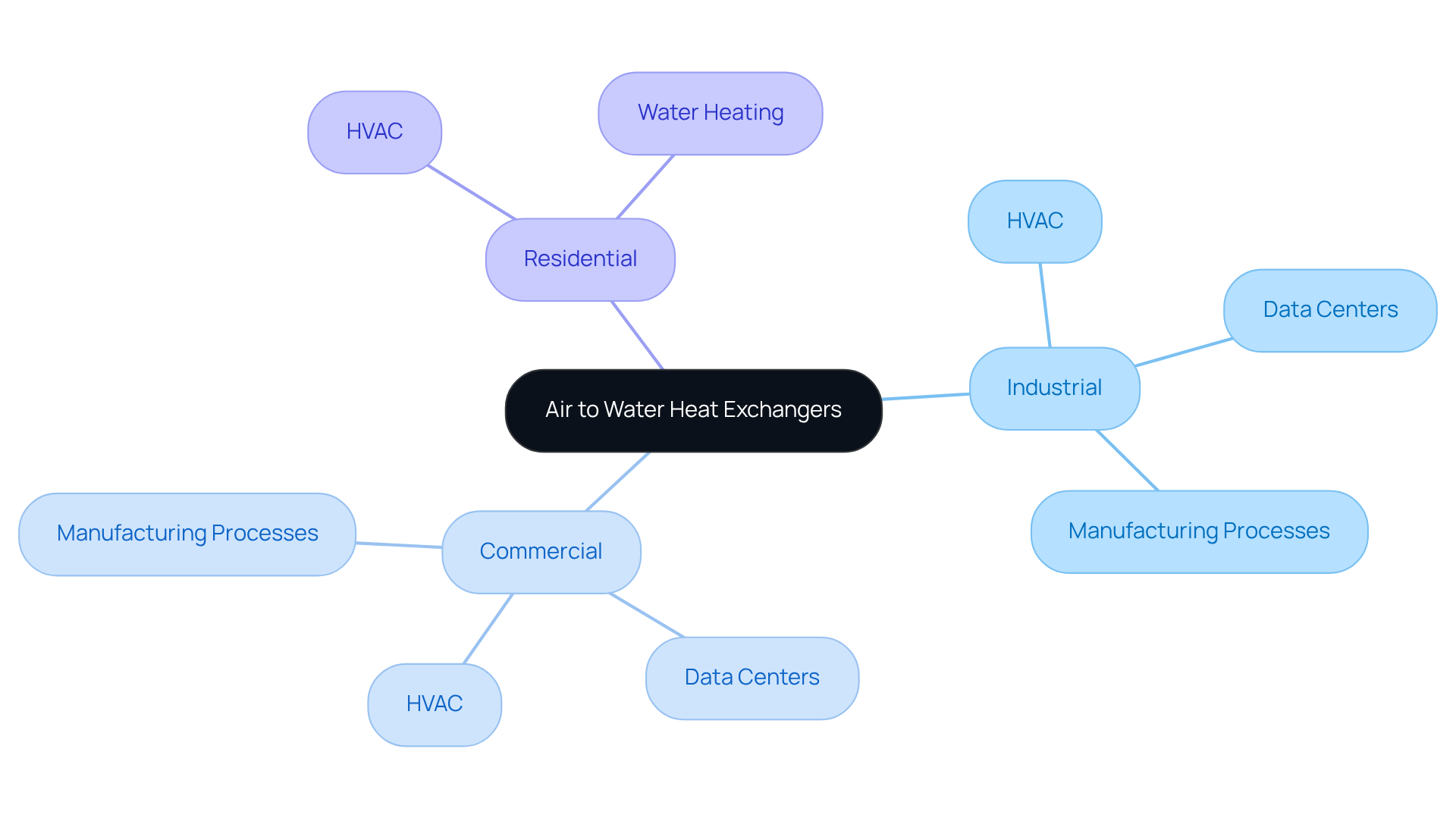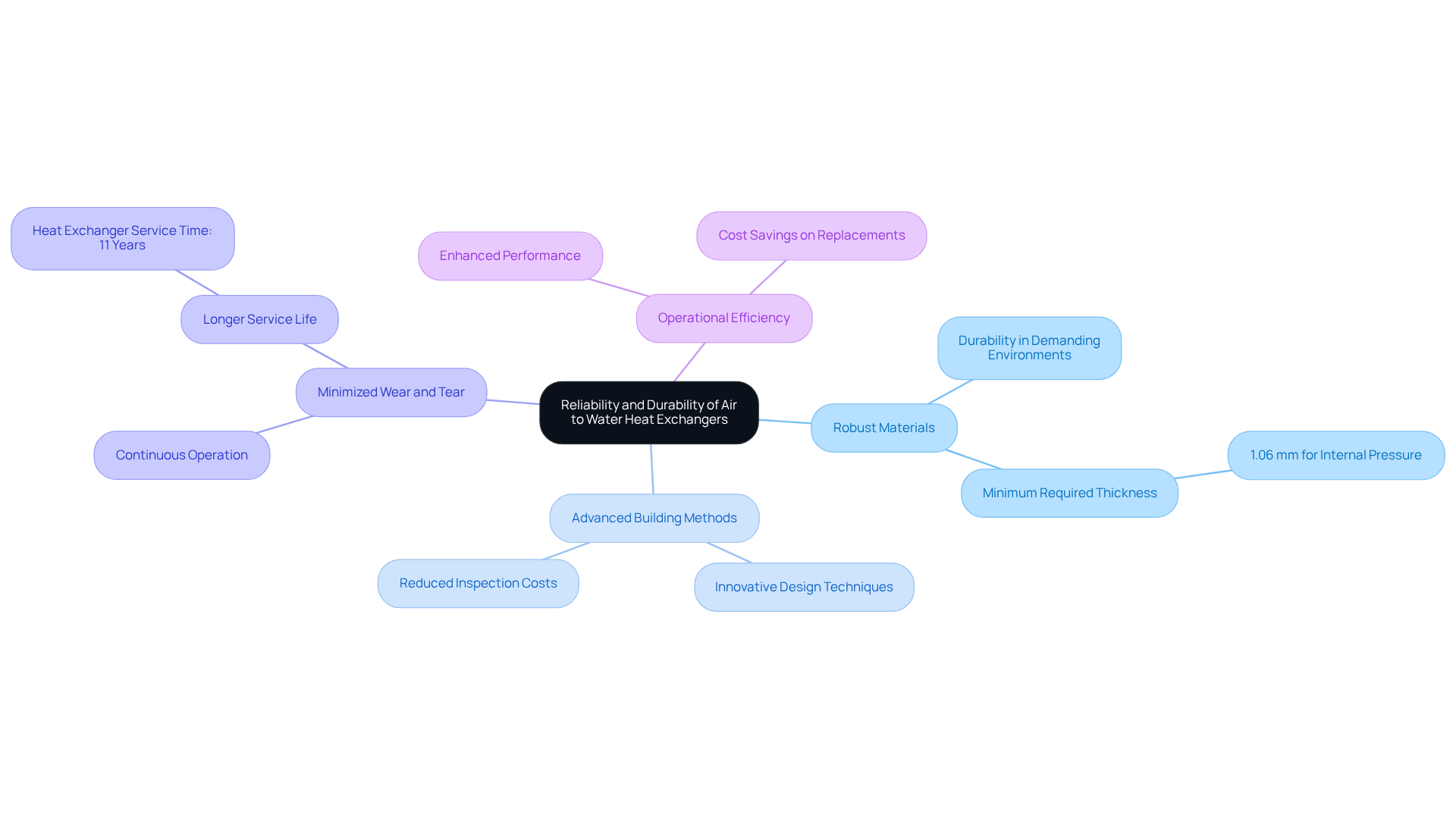Introduction
Air-to-water heat exchangers equipped with fans are revolutionizing thermal management, presenting engineers with a cutting-edge solution that merges efficiency with versatility. With the increasing demand for sustainable cooling technologies, these systems not only offer substantial energy savings but also elevate operational performance across a range of applications. Yet, a pressing question persists: how can engineers effectively harness these advancements to optimize their benefits while addressing the intricacies of installation and maintenance? This article delves into ten compelling advantages of air-to-water heat exchangers, illuminating their influence on cost-effectiveness, environmental sustainability, and overall engineering efficiency.
Gagner-Toomey Associates: Innovative Cooling Solutions with Air to Water Heat Exchangers
Gagner-Toomey Associates stands at the forefront of advanced temperature regulation solutions, particularly through air-to-water thermal transfer devices. These systems play a crucial role in optimizing thermal management for electronic applications, ensuring devices operate efficiently and reliably. The global air-to-water thermal transfer market, valued at USD 3.4 billion in 2024, is projected to grow at a CAGR of 7.1%, reaching USD 6.2 billion by 2033. This growth underscores the increasing demand for effective temperature regulation solutions within the electronics industry.
Engineers recognize the importance of innovative temperature control technologies. Industry leaders emphasize that engineering is fundamentally about practical problem-solving. Successful implementations of the air to water heat exchanger with fan have demonstrated their effectiveness across various applications, including HVAC and industrial process refrigeration. These systems not only enhance thermal management but also contribute to energy efficiency, aligning with the industry’s shift towards sustainable practices.
Recent advancements in temperature regulation solutions, such as the integration of IoT technologies and smart control systems, significantly boost performance and adaptability. By partnering with Gagner-Toomey, engineers gain access to cutting-edge solutions that address complex thermal challenges, reinforcing the company’s reputation as a trusted ally in the electronics sector.

Energy Efficiency: Lower Operating Costs with Air to Water Heat Exchangers
The air to water heat exchanger with fan systems are notable for their remarkable energy efficiency, significantly reducing operating expenses. These systems, using an air to water heat exchanger with fan, transfer warmth more effectively than air alone by utilizing water as a refrigerant, leading to lower energy consumption. This efficiency not only results in decreased utility bills but also bolsters the overall sustainability of engineering projects. Consequently, they present a compelling option for engineers who are mindful of costs.
Moreover, the integration of an air to water heat exchanger with fan systems can enhance project viability. For instance, in a recent case study, a commercial building that adopted this technology reported a 30% reduction in energy costs within the first year. Such data underscores the financial advantages of these systems, making them an attractive choice for cost-conscious engineers.
In conclusion, embracing an air to water heat exchanger with fan not only promotes energy efficiency but also contributes to sustainable engineering practices. Engineers looking to optimize their projects should consider these systems as a viable solution to enhance both performance and cost-effectiveness.

Enhanced Cooling Performance: Benefits of Integrated Fans in Heat Exchangers
The integration of fans in an air to water heat exchanger with fan devices markedly improves temperature regulation performance. By facilitating consistent airflow through the thermal transfer coils, an air to water heat exchanger with fan guarantees optimal temperature transfer rates. This enhanced capability is especially advantageous in high-demand applications where precise temperature control is essential. Engineers can rely on these systems to provide consistent cooling, even amid fluctuating load conditions, thereby reinforcing their critical role in effective thermal management.

Versatility: Applications of Air to Water Heat Exchangers in Diverse Settings
Air to water heat exchangers with fan present a versatile solution for effective thermal management across various settings, including industrial, commercial, and residential environments. Their frequent application in HVAC configurations, data centers, and manufacturing processes highlights their importance in maintaining optimal temperatures. This adaptability makes them suitable for both new installations and upgrades to existing systems, providing engineers with a range of options to meet specific cooling needs.
By integrating air to water heat exchangers into your projects, you can enhance efficiency and performance. These systems not only address immediate cooling requirements but also contribute to long-term sustainability goals. Consider the potential benefits of implementing these solutions in your next design or upgrade.

Ease of Installation and Maintenance: Simplifying Operations with Heat Exchangers
Air to water heat exchanger with fan systems are distinguished by their remarkable simplicity in both setup and maintenance. These systems feature user-friendly interfaces and straightforward plumbing connections, allowing for quick installation. Moreover, their minimal maintenance needs significantly reduce operational disruptions. This enables engineers to concentrate on their core tasks without the burden of complex upkeep. By adopting an air to water heat exchanger with fan, professionals can enhance efficiency and streamline their operations.

Environmental Benefits: Reducing Carbon Footprint with Efficient Cooling Solutions
Air to water exchangers are pivotal in minimizing the carbon footprint associated with cooling solutions. By leveraging water’s superior thermal capacity over air, these systems achieve enhanced efficiency, which translates to lower energy consumption and reduced greenhouse gas emissions. This efficiency is particularly crucial as the global pump market is projected to grow at a compound annual growth rate of 9.3%, reaching £136.08 billion by 2030, driven by the increasing demand for sustainable technologies.
Furthermore, the transition to air to water heat exchanger with fan devices aligns with the rising emphasis on eco-friendly solutions within engineering, making them a vital choice for modern applications. Sustainability experts emphasize that adopting such efficient cooling technologies not only fosters energy conservation but also plays a significant role in achieving broader climate objectives. This reinforces the necessity for innovation in mitigating our environmental impact.

Reliability and Durability: Long-Lasting Performance of Air to Water Heat Exchangers
Air to water thermal devices address a critical need for durability in demanding environments. Designed with robust materials and advanced building methods, these devices ensure lasting dependability. Their innovative design minimizes wear and tear, making them ideal for continuous operation, even under challenging conditions.
Engineers can confidently rely on these technologies, knowing they will perform reliably over time. This reliability significantly reduces the need for frequent replacements and repairs, ultimately saving time and resources. By investing in an air to water heat exchanger with fan, professionals can enhance operational efficiency and maintain high performance in their systems.

Cost-Effectiveness: Maximizing Value with Air to Water Heat Exchangers
Investing in an air to water heat exchanger with fan addresses the pressing issue of rising utility costs, making it a financially wise choice with significant long-term advantages. These systems are designed for energy efficiency, leading to considerable reductions in utility expenses. For example, a case study revealed that a residential installation could achieve annual savings of $304.30, demonstrating the potential for cost recovery within just a few years.
Moreover, the durability of these heat exchangers minimizes maintenance expenses, enhancing their overall value. Their adaptability across various applications allows engineers to implement these frameworks in diverse projects, maximizing return on investment. Financial analysts have observed that the return on investment (ROI) for energy-efficient cooling technologies can be compelling, often surpassing that of traditional systems.
Additionally, forecast data indicates a reduction in installed costs of 20-25% between 2020 and 2030 in the UK, further supporting the financial viability of these investments. With the ability to deliver both immediate and lasting savings, the air to water heat exchanger with fan emerges as a smart investment option for engineers seeking to optimize project expenses while promoting sustainability.

Technological Advancements: Innovations in Air to Water Heat Exchanger Design
Recent advancements in the air to water heat exchanger with fan technology have significantly enhanced efficiency and performance. These innovations include:
- Advanced heat transfer surfaces that optimize thermal exchange
- Smart controls for real-time monitoring and adjustments, maximizing operational efficiency
- Use of advanced materials that have improved durability and thermal conductivity, elevating system performance
Engineers can leverage these innovations to develop optimized temperature control solutions that meet the rigorous demands of modern applications while contributing to energy savings and sustainability. For instance, contemporary air to water heat exchangers with fan often feature modular structures, facilitating straightforward upkeep and scalability, making them suitable for various industrial applications. As one engineer noted, “The incorporation of intelligent technologies in air-to-water thermal devices is revolutionary, enabling unmatched control over cooling procedures.”
Moreover, the market for air to water heat exchanger with fan technology is projected to expand at a CAGR of 7.1%, reaching USD 5.68 billion by 2033, underscoring the rising demand for these technologies. The oil and gas sector is expected to account for a 28.6% share of the thermal transfer market by 2025, highlighting the critical role these systems play in key industries. These advancements position air-to-water thermal devices as essential components in achieving effective temperature control in electronics and beyond.

Customer Support: The Role of Service in Maximizing Air to Water Heat Exchanger Benefits
Effective customer support is crucial for maximizing the benefits of the air to water heat exchanger with fan. At Gagner-Toomey Associates, we prioritize our customers’ time and needs, fostering a consultative approach through our highly experienced and motivated team. Our comprehensive service packages – featuring installation assistance, maintenance training, and troubleshooting support – empower engineers to fully leverage these solutions.
Industry insights reveal that 82% of consumers place greater trust in companies that consistently deliver outstanding customer service. This statistic underscores the significance of reliable support in enhancing performance. Successful projects often attribute their effectiveness to robust service offerings, which ensure that systems operate efficiently and meet the diverse demands of various applications.
For example, the industrial segment, which represents over 45% of market revenue, illustrates the critical role of service in optimizing performance. Ongoing support not only boosts operational efficiency but also contributes to overall project success. This makes it a vital consideration for engineers in the electronics industry, especially as the air to water heat exchanger with fan market is projected to experience significant growth in the coming years.

Conclusion
The advantages of air to water heat exchangers with fans are substantial, providing engineers with innovative solutions for effective thermal management. These systems not only enhance energy efficiency but also contribute to sustainability, making them vital in an era increasingly focused on reducing environmental impact. By prioritizing these technologies, engineers can achieve optimal performance while addressing the pressing challenges of modern cooling needs.
Key points throughout this discussion highlight the energy efficiency of air to water heat exchangers, which significantly lowers operating costs and enhances project viability. The integration of fans improves cooling performance, while the versatility of these systems allows for application across various settings. Furthermore, their ease of installation and maintenance, coupled with reliability and durability, positions these heat exchangers as an attractive option for engineers. Financially, the long-term cost-effectiveness and ROI further reinforce their value in engineering projects.
In light of these insights, adopting air to water heat exchangers with fans emerges as not just a technical decision but a strategic one. Engineers are encouraged to consider these systems in their designs to promote energy efficiency and sustainability. As the demand for effective temperature regulation solutions continues to rise, embracing these advancements will not only enhance operational performance but also support broader environmental goals.
Frequently Asked Questions
What is Gagner-Toomey Associates known for?
Gagner-Toomey Associates is recognized for its innovative cooling solutions, particularly through air-to-water heat exchangers that optimize thermal management for electronic applications.
What is the projected growth of the air-to-water thermal transfer market?
The global air-to-water thermal transfer market is valued at USD 3.4 billion in 2024 and is projected to grow at a CAGR of 7.1%, reaching USD 6.2 billion by 2033.
How do air-to-water heat exchangers benefit energy efficiency?
Air-to-water heat exchangers with fans transfer warmth more effectively by using water as a refrigerant, leading to lower energy consumption and reduced operating expenses.
Can you provide an example of the financial benefits of using air-to-water heat exchangers?
A commercial building that adopted air-to-water heat exchanger technology reported a 30% reduction in energy costs within the first year, highlighting the financial advantages of these systems.
What role do recent advancements play in temperature regulation solutions?
Recent advancements, such as the integration of IoT technologies and smart control systems, significantly enhance the performance and adaptability of temperature regulation solutions.
How do integrated fans improve the performance of air-to-water heat exchangers?
Integrated fans facilitate consistent airflow through thermal transfer coils, ensuring optimal temperature transfer rates and reliable cooling performance, especially in high-demand applications.
Why are air-to-water heat exchangers considered sustainable?
These systems contribute to sustainability by reducing energy consumption and operating costs, aligning with the industry’s shift towards more environmentally friendly practices.

